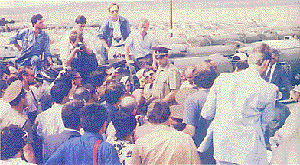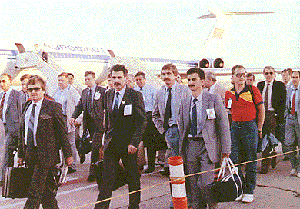 During the baseline inspection period (July - August 1988), the media observed the first eliminations of missiles. On August 1, 1988, dozens of Soviet and international media were at the Saryozek Elimination Facility where they were briefed by a Soviet officer on the SS-12 missile elimination process. |
The first
Soviet INF missile eliminations began on July 22 at
Kapustin Yar. An American inspection team monitored this
elimination, as they did all subsequent scheduled
eliminations. The treaty also granted the inspecting
party the right to conduct closeout inspections of INF
missile bases and facilities that had been declared to no
longer have any INF missile systems or INF related
activities. During the eight-week baseline period,
American inspection teams conducted 16 closeout
inspections.* By the end of July 1988, four of the five
types of on-site inspections were under way: baseline,
continuous portal monitoring, elimination, and closeout.
In July and August, there were so many U.S. inspections
of Soviet INF sites that the U.S. Air Force had flights
into and out of Moscow every day and flights every other
day to and from Ulan-Ude. It was an intense, exciting
time; it set the tone for all subsequent treaty on-site
inspections. In the summer of 1988, the international media contributed to the excitement. In the United States, Soviet Union, and Europe, journalists and television reporters focused on the INF Treaty and the men and women involved in the new on-site inspections. They interviewed team chiefs, inspectors, and senior escorts at the airports, in the cities, and, on occasion, at the sites. Colonel Kelley, for instance, was approached by a TASS reporter and asked about his experience in leading the first American on-site inspection. Speaking in fluent Russian, Kelley remarked, "It is clear to us that the Soviet side is interested in facilitating our inspections. Excellent conditions were created for our work and we are quite satisfied. "13 This interview was conducted on July 7 at Moscow's Sheremetyevo Airport. * The treaty stipulated that during the baseline period, that baseline inspections would constitute closeout inspections. |
